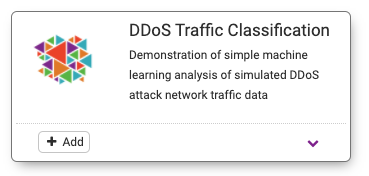DDoS Classification using Machine Learning
Overview
Teaching: 10 min
Exercises: 30 minQuestions
What is a DDoS attack?
How can we use machine learning to train a model to identify attack and benign network traffic?
Objectives
Follow instructions to train and test a machine learning model that identifies DDoS attack traffic.
DDoS Attacks
Distributed denial-of-service (DDoS) is an attempt by nefarious actors to overwhelm a server or network by flooding it with spurious network traffic that prevents legitimate users from accessing the server or network. The attacker often uses several other previously hacked sources to conduct this attack, hence the term distributed, as there is no single source of attack.
In order to use machine learning to perform real-time detection of such attacks so that they can be mitigated as soon as possible, we will need to train the model on a well-labeled, comprehensive dataset. Such a dataset needs to include network traffic corresponding to various kinds of modern DDoS attacks. In this demonstration, we use the DDoS Evaluation Dataset published by the Canadian Institute for Cybersecurity. This dataset includes a training and test dataset of network traffic data that has been labeled with either the kind of DDoS attack or as benign in the case of background traffic data. We will demonstrate how the data can be used to train and test simple classification models (logistic regression) that discriminate between:
- Attacks based on NetBIOS versus benign traffic
- Attacks based on Portmap versus benign traffic
- Attacks based on NetBIOS versus attacks based on SYN
Demonstration
The demonstration on CHEESEHub illustrates the application of machine learning to this dataset via a single container using Jupyter notebooks. The Python scikit-learn library is used to conduct the machine learning training and testing, and Pandas is used to ingest and manage the datasets which are provided in the form of comma separated value (csv) files. Since the original dataset is too large to process efficiently on limited computing memory, the demonstration only uses a small subset of the dataset. Our intent here is to simply demonstrate the use of machine learning for this analysis task; various other approaches including parallel processing of chunks using a library like Dask, or other big data technologies such as Apache Spark can be used to work with the entire dataset.
Briefly in this demonstration you will do the following:
- Ingest the data into Pandas and inspect it to identify the various data fields and their types.
- Identify a reasonable set of numerical fields that can be used in the machine learning model.
- Prepare the necessary datasets with appropriate output label values for training and testing the model.
- Study the performance of the learned model on the test dataset.
Getting Started
You will need to create an account on CHEESEHub to work through this exercise. Each container in this demonstration has a web interface and is accessible through your web browser, no other special software is needed.
We will start by first adding the DDoS Traffic Classification application:

Next, click the View link to go to the application-specific page and start the application container:

Container Launch Errors
If a container fails to start, you will see a flashing warning icon next to the container’s name. Take a look at the logs to determine the cause of failure and try deleting the application and restarting.
Once the container has started, launch its web interface in a separate browser tab by clicking the open link next to the container’s name:

Click on ddos-classification.ipynb to open a Jupyter notebook containing instructions on working through this demonstration:

Step through the instructions for each of the five sections, filling in the code where it is marked as TODO. To execute a code cell, you can either use the menu bar at the top or the key combination Shift+Enter:

What does the exercise tell us?
Here we used a specific machine learning algorithm, logistic regression to perform classification where there are only two classes. Despite using only a small subset of the original dataset, we observe very good classification performance due to the overabundance of DDoS attack training data. Feel free to redo the steps by choosing a different set of fields for the training process and study the performance of the model.
Key Points
We are utilizing a specific model, logistic regression to classify network traffic data into benign and attack classes
The data being used is not raw network traffic data, but pre-processed data that is conducive to machine learning analysis
When a lot of training data is provided, machine learning is able to learn fairly accurate models